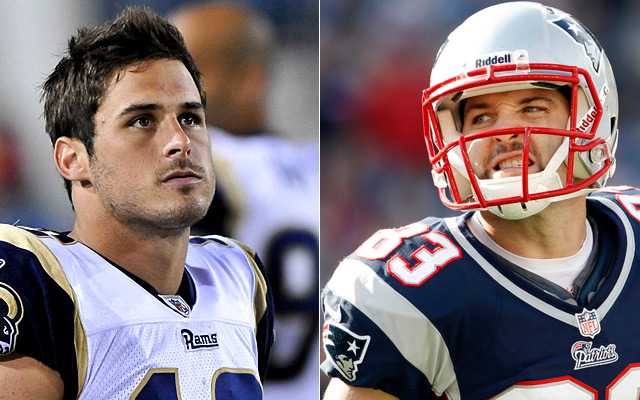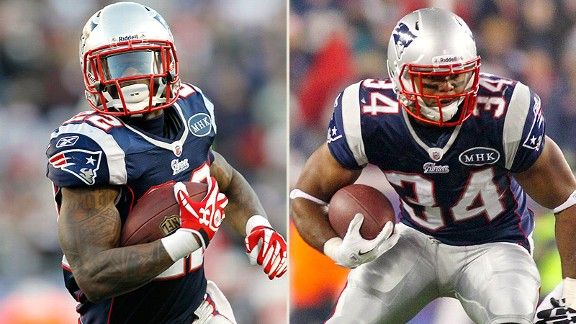Football season is upon us ladies and gentlemen! The Patriots played their final preseason game tonight and will trim the last fat off of a roster that, in some ways, is much improved over last season. They lost some key players and have made some nice additions to their team that will, in the long term, reap great benefits. Let's take a look at the offensive side of the ball as there were some extremely interesting and controversial signings there.
 |
You may have heard, and if you haven't then I may ask if you've been living under a rock all summer, that the Patriots signed quarterback Tim Tebow this off season. So many people make a huge deal over this signing because of who he is and the media circus that he brings to the team. In reality, he's nothing more than a third string quarterback who will never see any time on the field this season. No, they aren't going to create a separate playbook to incorporate him into the offense. For all you people that think they are going to draw up trick plays for him and he's going to see some time on the field. That's just not going to happen. The Pats aren't going to waste valuable practice time, and take time away from Brady's preparation, so they can work this guy into the offense. At MOST, he'll help the team in practice prepare for scrambling quarterbacks when they have one coming up on the schedule. He'll sit on the bench, probably pray a couple times a game and get way more camera time than he deserves. I'm not by any means a Tebow apologist as I think that there are probably 20 or more free agent quarterbacks that could come in right now and be a more productive backup than him. Who knows, this may be one of those pride moves for Belichick where he wants to prove he can make something of a man that nobody else could. I just don't think it's worth crucifying (see what I did there?) Belichick over. If I've learned anything over the years, it's that I trust the man in charge. (Note that as I write this, there is a very good chance that Tebow could be cut before the season begins next Sunday)
As we're coming out of preseason I've been thinking about who the key contributors at every position will be and what the depth charts will look like heading in to the season. Offensively this is how I see things shaking out.
Quarterback: Tom Brady, Ryan Mallet, Tim Tebow
Tom Brady is Tom Brady. The guy is coming off of one of his best seasons he's ever had throwing for 4,827 yards, 34 touchdowns and a sterling 8 interceptions. The guy is like a fine wine. He get's better with age. This season will certainly have a learning curve in the early stages with all the new faces Tom will be throwing to but once they get some games under their belt, expect much of the same from Brady and the Pats. If we've learned anything from him in the past, Tom Brady makes it work regardless of who he is throwing the ball to and in most cases, he makes the players he's throwing to look like All-Pros. This is a make or break season for Ryan Mallet. He's not going to get many glimpses of game action unless, God forbid, Brady goes down for some reason, so it'll be hard to evaluate exactly how the 3rd year backup has progressed. He has been mentioned by many media outlets as a guy that could be traded for by a team that needs a starting quarterback and I'm not exactly sure he proved he can come in a be that guy for a team.
Brady projected stat line: 4,650 yds, 38 TDs, 10 INT
Mallet projected stat line: Let's hope he doesn't have one
Offensive line: LT Nate Solder, LG Logan Mankins, C Ryan Wendell, RG Dan Connolly, RT Sebastian Vollmer
Not much has changed here. Third year man Nate Solder is protecting Brady's blindside for a second straight season. You didn't hear a whole lot about him last year and I guess that's a good thing considering it means he wasn't doing anything wrong. He was sound and athletic on the edge, and much improved from his rookie season. He'll look to build on that this year. Mankins is the quintessential guard. An absolute mauler who loves nothing more than smashing the face of the defender in front of him. He's the unquestioned leader of this line and provides excellent pass and run support. An important cog in this offensive line is Vollmer. When he's healthy, he's one of the best right tackles in the NFL, but he seems to be one of those guys who always contracts a nagging injury that keeps him out way longer than you think it should. If this line can stay healthy, it will continue the trend of being one of the top 5 offensive lines in the NFL.
Running backs: Stevan Ridley, Shane Vereen, LeGarrette Blount, Leon Washington, Brandon Bolden
Ridley is entering his third NFL season and his second as the feature back of this offense. He broke out last season amassing 1,263 rushing yards, 18 total touchdowns and a 4.4 yards per carry average. He's not overly flashy but he proved last year he's someone whom you can give the ball to consistently between the tackles on first and second down and will take care of the football. Shane Vereen is one of my key players to watch this year. Danny Woodhead was shown the door in free agency as he bolted to the Chargers and Vereen will fill his spot as the third down, pass catching back seamlessly. Vereen has the skillset to be a weapon out of the backfield and make you forget Danny Woodhead was even a human. Vereen has exceptional hands and top end speed making him a huge asset in the passing game and a player that Brady will look to often. Blount adds an interesting wrinkle into the Pats running game as he's something they haven't really had in the past few seasons; a real power back. Blount is a monster of a running back and hardly ever gets taken down by the first tackler. He'll be used in short yardage and goal line situations and should be a very useful runner out of the backfield. Washington has the reputation as one of the best kick returners in the NFL and that's mostly where you'll see him used, but don't be surprised if you also see him catching some passes out of the backfield and spelling Shane Vereen.
Ridley projected stat line: 1,215 yds, 10 rushing TDs, 3 receiving TDs 4.6 yards per carry.
Vereen projected stat line: 425 rushing yards, 4 rushing TDs, 410 receiving yards, 4 receiving TDs
Blount projected stat line: 360 yds, 6 TDs
Wide receivers: Danny Amendola, Kenbrell Thompkins, Julian Edelman, Aaron Dobson, Josh Boyce, Matthew Slater
Danny Amendola is going to be the key guy here. As I stated above he is going to be Welker's replacement and even more because I've heard that he'll be lining up a lot outside of the numbers as well as inside, which brings more versatility to his role. He's sure handed and from all accounts a fast learner so I expect him to have a huge season as the Patriots go-to wideout. Rookie Kenbrell Thompkins is a fantastic story. Kenbrell is a former juvenile delinquent and drug dealer who decided to clean his act up, go to the University of Cincinatti and take this football thing seriously. Signed as an undrafted rookie, the six foot receiver has burst on to the scene impressing the coaching staff and hurdling over several other rookies who looked to be ahead of him going into training camp. He's quickly earned the trust of Tom Brady and has had some great games and flashes in the preaseason which lead me to believe he'll be the wide receiver lining up on the outside opposite Danny Amendola. Julian Edelman will see a huge amount of time in the slot and be the shifty, run after the catch receiver we've seen him be in the past. Injury is something Edelman has to avoid this year as Brady will be depending on him more heavily now, than in years past. Aaron Dobson, the Patriots second round draft pick is a 6'3, 210 lb specimen at the wide receiver spot. He has freakish hands and leaping ability that will undoubtedly make for some highlight reel catches this year, much like this one from his senior year at Marshall: "The Catch". He could very well finish this season as the second or third best wide receiver on the team. Josh Boyce is a strong, compact rookie wideout from TCU who can come in and do some special things in this offense. He provides the team something they have lacked in recent years, a guy with 4.30 speed that can get down the field. I expect him to be utilized on a lot of deep routes, and screen passes as he can be dangerous after the catch in the open field.
Amendola projected stat line: 89 rec, 1,100 yds, 6 TDs
Kenbrell Thompkins: 56 rec, 840 yds, 5 TD
Julian Edelman: 50 rec, 660 yds, 3 TD
Aaron Dobson: 40 rec, 520 yds, 4 TD
Josh Boyce: 35 rec, 410 yds, 3 TD
Tight Ends: Rob Gronkowski, Jake Ballard, Zach Sudfeld
The legend of Gronk continues on to another season. Unfortunately this season it begins with Gronk sidelined as he recovers from a broken wrist and offseason back surgery. When he returns, you should expect him to quickly take back his role as the best tight end in all of football. Maybe not right away, but the man is a freak of nature and I wouldn't put anything past him. To start the season, you'll see a lot of Jake Ballard and Zach Sudfeld. Ballard was an up and coming TE for the Giants before tearing his ACL in the Super Bowl against the Patriots which put an abrupt halt to his development. He has good hands an athleticism for a guy that stands at 6'7 and is also proficient in the blocking game. Sudfeld is a very interesting prospect. From what I've seen so far he has a lot of the unteachable tools that Gronk has on the field. He's extremely athletic and adjusts very well in the air to make difficult catches look easy. Also, much like Gronk, he is very strong in the blocking game and will be a huge contributor in that area of the game as that's one of the best ways to get on Belichick's good side.
Gronkowski projected stat line: 50 rec, 700 yds, 5 TD
Ballard projected stat line: 30 rec, 290 yds, 2 TD
Zach Sudfeld: 30 rec, 350 yds, 3 TD
If all goes according to plan, and it rarely does, that's how I see it playing out. Obviously injuries, cuts, and whatnot will follow this final preseason game but I think this offense, while slightly young and inexperienced, has the potential to do some special things. It may take them a couple weeks to get into the full swing of things, but I would expect them to be the same high octane offense they usually are and put up 30+ points a game. They could possibly be a little more run oriented than we've seen in the past as they have a pretty special stable of running backs, but overall this offense will be a force to be reckoned with.
Keep your eyes peeled for my next piece where I take a look at the defensive side of the ball and what you should expect from your beloved Patriots in that area.
Be well.
-ZHawk








